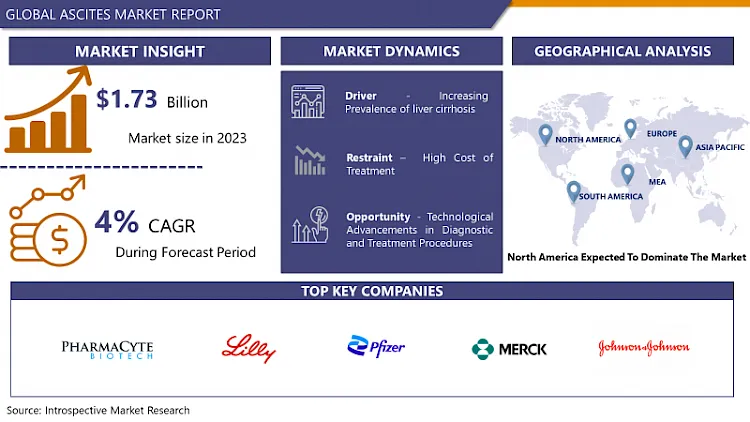Ascites Market Synopsis
Ascites Market Size Was Valued at USD 1.73 Billion in 2023 and is Projected to Reach USD 2.46 Billion by 2032, Growing at a CAGR of 4% From 2024-2032.
The ascites market refers to the healthcare sector that addresses the diagnosis, treatment, and management of ascites, a condition characterized by the accumulation of fluid in the abdominal cavity.
- This market includes pharmaceuticals, medical devices, and diagnostic tools aimed at alleviating the symptoms and underlying causes of ascites, often associated with liver cirrhosis, heart failure, or cancer. It is a critical area of focus for healthcare providers and pharmaceutical companies, as ascites can lead to serious complications and significantly impact patients' quality of life. Ongoing research and innovation continue to drive advancements in ascites management.
- The global ascites market was witnessing growth due to the rising prevalence of conditions that can lead to ascites, including liver cirrhosis, heart failure, and certain cancers. Liver cirrhosis, often associated with excessive alcohol consumption and viral hepatitis, remains a significant contributor to ascites cases worldwide. With changing lifestyles and a global increase in obesity and alcohol consumption, the incidence of liver cirrhosis and, subsequently, ascites, was on the rise. This growing patient pool was a key driver for pharmaceutical companies and healthcare providers to invest in research, diagnosis, and treatment options for ascites.
- The ascites market was benefiting from continuous technological advancements in diagnostic and therapeutic tools. Innovations in imaging techniques, such as ultrasound and MRI, were improving the early detection and monitoring of ascites. Moreover, minimally invasive procedures for ascites management, like paracentesis and trans jugular intrahepatic portosystemic shunt (TIPS), were becoming more efficient and safer for patients. These technological developments enhanced patient outcomes and led to a surge in the adoption of these methods, fostering market growth.
- The aging global population, particularly in developed countries, was contributing to the growth of the ascites market. As people age, they become more susceptible to the conditions that cause ascites, such as cirrhosis and heart failure. Furthermore, improvements in healthcare infrastructure in emerging economies were increasing access to ascites diagnosis and treatment options.


Ascites Market Trend Analysis
Increasing Prevalence of Liver Cirrhosis
- Excessive alcohol consumption remains a primary contributor to the rising prevalence of liver cirrhosis. Chronic alcohol abuse can lead to alcoholic liver cirrhosis, which is characterized by the scarring of liver tissue. The global expansion of alcohol availability and changing drinking patterns have led to an increase in alcohol-related liver diseases. Additionally, unhealthy lifestyles marked by poor dietary choices, sedentary habits, and obesity have contributed to non-alcoholic fatty liver disease (NAFLD), which can progress to cirrhosis over time. The rise in these risk factors has driven the surge in cirrhosis cases.
- Chronic viral infections, particularly hepatitis B and hepatitis C, are significant factors in the increasing prevalence of liver cirrhosis. These viruses can cause persistent liver inflammation, leading to cirrhosis if left untreated. Despite efforts to control and vaccinate against hepatitis, many individuals worldwide remain unaware of their infection status, which allows the viruses to progress and contribute to the growing burden of cirrhosis cases.
- The aging population is another critical driver of the rising prevalence of liver cirrhosis. As people age, their liver function tends to decline, making them more susceptible to liver diseases. Individuals who may have engaged in risky behaviors earlier in life (such as heavy alcohol consumption) may develop cirrhosis as they age. With the global demographic shift toward an older population, there is an increased number of individuals at risk for liver cirrhosis, further exacerbating its prevalence.
Technological Advancements in Diagnostic and Treatment Procedures
- Technological innovations have led to more accurate and non-invasive diagnostic methods, such as advanced imaging techniques and biomarker analysis. Early detection of ascites allows for timely intervention and management, reducing the progression of the underlying conditions and improving patient outcomes. This presents an opportunity to enhance patient care and potentially reduce the economic burden of advanced disease management.
- Modern technology allows for a more personalized approach to treatment. The ability to precisely identify the cause and severity of ascites enables healthcare providers to tailor interventions to individual patient needs. Whether it's paracentesis, drug therapies, or surgical procedures, customization based on diagnostic insights can optimize the effectiveness of treatment, minimize side effects, and improve patient quality of life.
- Advancements in diagnostic and treatment procedures attract increased interest and investment from pharmaceutical companies, medical device manufacturers, and healthcare providers. This, in turn, fosters innovation and competition within the ascites market. As new technologies and therapies emerge, there is a potential for expanded market offerings, creating opportunities for companies to gain a competitive edge and contribute to improved patient care.
According to Statista Above Graph Shows That Medical Technology Is Growing, which directly contributes to the expansion of the ascites market. Advances in medical technology lead to more effective diagnostic tools, treatment options, and patient care within the ascites field, fostering its growth by improving early detection, treatment outcomes, and overall market innovation.
Ascites Market Segment Analysis:
Ascites Market Segmented on the basis of type, Diagnosis, Treatment, End-users, and Distribution Channel.
Transudative segment is expected to dominate the market during the forecast period
- The term "Transudative" refers to a specific type of fluid accumulation in the abdominal cavity known as ascites. Transudative ascites are characterized by the presence of clear, straw-colored fluid within the abdominal cavity. This type of ascites is primarily caused by non-inflammatory conditions, often related to systemic issues such as liver cirrhosis, heart failure, or hypoalbuminemia. The underlying mechanism behind transudative ascites is an imbalance in fluid and protein distribution in the body, leading to the accumulation of this clear fluid in the peritoneal cavity.
- The prevalence and management of transudative ascites is crucial for healthcare providers and pharmaceutical companies. Treatments and therapies for transudative ascites are often directed at addressing the root causes, such as managing liver disease or heart conditions.
Hospitals and Clinics segment held the largest share of 55% in 2022
- Hospitals and clinics are the primary healthcare institutions where patients suffering from ascites seek medical attention and treatment. Ascites are often a symptom of an underlying medical condition, such as liver cirrhosis or heart failure, which requires specialized medical care and diagnosis. Hospitals and clinics are equipped with state-of-the-art diagnostic facilities, medical professionals, and specialized departments, such as gastroenterology and hepatology, which are crucial for diagnosing and managing ascites effectively.
- The prevalence of ascites is often associated with chronic diseases, particularly liver diseases, and the aging population. As the global population continues to age and the incidence of chronic diseases rises, the demand for ascites-related healthcare services is also on the rise. Hospitals and clinics are well-equipped to handle the complex needs of patients with ascites, as they can provide integrated care through a multidisciplinary approach involving specialists in various fields.
Ascites Market Regional Insights:
North America is Expected to Dominate the Market Over the Forecast Period
- The region has a high prevalence of liver cirrhosis, which is one of the major underlying causes of ascites. Liver cirrhosis is often a consequence of chronic alcohol consumption and various liver diseases, and it can lead to the accumulation of fluid in the abdominal cavity, resulting in ascites. The lifestyle and dietary habits in North America have contributed to a higher incidence of liver cirrhosis, necessitating the need for diagnosis and management of ascites. This high prevalence of cirrhosis acts as a driver for the ascites market in the region, as healthcare providers and patients seek effective diagnostic and treatment solutions to manage this condition.
- North America's ascites market benefits from the presence of key market players and research institutions. The region is home to a robust healthcare and pharmaceutical industry with advanced research and development capabilities. This facilitates the development of innovative diagnostic tools, therapies, and medications for ascites management. The collaboration between research institutions and healthcare companies allows for the creation of cutting-edge technologies and treatment options, further enhancing the ascites market's growth.
- The increasing adoption of advanced diagnostic and treatment procedures in North America is contributing significantly to the market's expansion. As the healthcare landscape evolves, patients and healthcare providers are increasingly embracing advanced diagnostic techniques and treatment modalities for ascites. These include advanced imaging technologies, minimally invasive procedures, and novel medications that improve the accuracy of diagnosis and the effectiveness of treatment. The patient population in North America is often well-informed and proactive in seeking the latest medical innovations, further boosting the ascites market by driving the demand for these advanced solutions.
Ascites Market Top Key Players:
- PharmaCyte Biotech(USA)
- Eli Lilly and Company (USA)
- Pfizer (USA)
- Merck (USA)
- BioVie – USA
- Johnson & Johnson Private Limited (USA)
- BD (Becton, Dickinson and Company) (USA)
- GI Supply (USA)
- Mylan (USA)
- GE (General Electric) (USA)
- Boston Scientific (USA)
- Gilead Sciences Inc. (USA)
- Cook Medical (USA)
- Medtronic (USA)
- Baxter International (USA)
- Fresenius Medical Care (Germany)
- Bayer (Germany)
- B. Braun (Germany)
- Diaverum (Sweden)
- Vifor Pharma (Switzerland)
- Sequana Medical (Switzerland)
- Nikkiso (Japan)
- Otsuka Pharmaceutical (Japan)
- Asahi Kasei (Japan)
- Teva Pharmaceutical Industries (Israel)
- Trion Pharma (Turkey)
Key Industry Developments in the Ascites Market:
- In January 2024, Sequana Medical NV, a pioneer in fluid overload treatment for liver disease, heart failure, and cancer, announced the US FDA's acceptance of the Premarket Approval (PMA) application for its alfapump. This fully implantable, wirelessly charged device addresses recurrent or refractory ascites due to liver cirrhosis and received breakthrough device designation in 2019. The FDA's substantive review marks a significant milestone for Sequana Medical in advancing innovative healthcare solutions.
- In March 2022, Gilead Sciences announced that it had acquired Principia Biopharma, a company developing a new ascites treatment. The resources and expertise of Gilead Sciences are anticipated to expedite the treatment's introduction to the market, giving promise to patients suffering from this challenging condition.
- In September 2021, Johnson & Johnson announced a partnership with Arbutus Biopharma to develop and commercialize an ascites drug candidate. The agreement combines the assets of both companies, and it is anticipated that the partnership will result in significant market advancements.
|
Ascites Market |
||||
|
Base Year: |
2023 |
Forecast Period: |
2024-2032 |
|
|
Historical Data: |
2017 to 2023 |
Market Size in 2023: |
USD 1.73 Bn. |
|
|
CAGR (2024-2032): |
4 % |
Market Size in 2032: |
USD 2.46 Bn. |
|
|
Segments Covered: |
by Type |
|
|
|
|
by Diagnosis |
|
|
||
|
by Treatment |
|
|
||
|
by End Users |
|
|
||
|
by Distribution Channel |
|
|
||
|
by Region |
|
|
||
|
Key Market Drivers: |
|
|||
|
Key Market Restraints: |
|
|||
|
Key Opportunities: |
|
|||
|
Companies Covered in the Report: |
|
|||
INTRODUCTION
RESEARCH OBJECTIVES
RESEARCH METHODOLOGY
RESEARCH PROCESS
SCOPE AND COVERAGE
Market Definition
Key Questions Answered
MARKET SEGMENTATION
EXECUTIVE SUMMARY
MARKET OVERVIEW
GROWTH OPPORTUNITIES BY SEGMENT
MARKET LANDSCAPE
PORTER’S FIVE FORCES ANALYSIS
Bargaining Power of Supplier
Threat of New Entrants
Threat of Substitutes
Competitive Rivalry
Bargaining Power Among Buyers
INDUSTRY VALUE CHAIN ANALYSIS
MARKET DYNAMICS
Drivers
Restraints
Opportunities
Challenges
MARKET TREND ANALYSIS
REGULATORY LANDSCAPE
PESTLE ANALYSIS
PRICE TREND ANALYSIS
PATENT ANALYSIS
TECHNOLOGY EVALUATION
ANALYSIS OF THE IMPACT OF COVID-19
Impact On The Overall Market
Impact On The Supply Chain
Impact On The Key Manufacturers
Impact On The Pricing
Post COVID Situation
MARKET IMPACT OF THE RUSSIA-UKRAINE WAR
Geopolitical Market Disruptions
Supply Chain Disruptions
Instability in Emerging Markets
ECOSYSTEM
ASCITES MARKET BY TYPE (2017-2032)
ASCITES MARKET SNAPSHOT AND GROWTH ENGINE
MARKET OVERVIEW
TRANSUDATIVE
Introduction and Market Overview
Historic and Forecasted Market Size in Value (2017 – 2032F)
Historic and Forecasted Market Size in Volume (2017 – 2032F)
Key Market Trends, Growth Factors and Opportunities
Geographic Segmentation Analysis
EXUDATIVE
ASCITES MARKET BY DIAGNOSIS (2017-2032)
ASCITES MARKET SNAPSHOT AND GROWTH ENGINE
MARKET OVERVIEW
ULTRASOUND
Introduction and Market Overview
Historic and Forecasted Market Size in Value (2017 – 2032F)
Historic and Forecasted Market Size in Volume (2017 – 2032F)
Key Market Trends, Growth Factors and Opportunities
Geographic Segmentation Analysis
CT SCAN
MRI
BLOOD TEST
LAPAROSCOPY
ANGIOGRAPHY
ASCITES MARKET BY TREATMENT (2017-2032)
ASCITES MARKET SNAPSHOT AND GROWTH ENGINE
MARKET OVERVIEW
MEDICATION
Introduction and Market Overview
Historic and Forecasted Market Size in Value (2017 – 2032F)
Historic and Forecasted Market Size in Volume (2017 – 2032F)
Key Market Trends, Growth Factors and Opportunities
Geographic Segmentation Analysis
PARACENTESIS
SURGERY
ASCITES MARKET BY END USERS (2017-2032)
ASCITES MARKET SNAPSHOT AND GROWTH ENGINE
MARKET OVERVIEW
HOSPITALS AND CLINICS
Introduction and Market Overview
Historic and Forecasted Market Size in Value (2017 – 2032F)
Historic and Forecasted Market Size in Volume (2017 – 2032F)
Key Market Trends, Growth Factors and Opportunities
Geographic Segmentation Analysis
HOMECARE
SPECIALTY CLINICS
ASCITES MARKET BY DISTRIBUTION CHANNEL (2017-2032)
ASCITES MARKET SNAPSHOT AND GROWTH ENGINE
MARKET OVERVIEW
HOSPITAL PHARMACY
Introduction and Market Overview
Historic and Forecasted Market Size in Value (2017 – 2032F)
Historic and Forecasted Market Size in Volume (2017 – 2032F)
Key Market Trends, Growth Factors and Opportunities
Geographic Segmentation Analysis
RETAIL PHARMACY
ONLINE PHARMACIES
COMPANY PROFILES AND COMPETITIVE ANALYSIS
COMPETITIVE LANDSCAPE
Competitive Positioning
ASCITES Market Share by Manufacturer (2022)
Industry BCG Matrix
Heat Map Analysis
Mergers & Acquisitions
PHARMACYTE BIOTECH
Company Overview
Key Executives
Company Snapshot
Role of the Company in the Market
Sustainability and Social Responsibility
Operating Business Segments
Product Portfolio
Business Performance (Production Volume, Sales Volume, Sales Margin, Production Capacity, Capacity Utilization Rate)
Key Strategic Moves and Recent Developments
SWOT Analysis
ELI LILLY AND COMPANY (USA)
PFIZER (USA)
MERCK (USA)
BIOVIE – USA
JOHNSON & JOHNSON PRIVATE LIMITED (USA)
BD (BECTON, DICKINSON AND COMPANY) (USA)
GI SUPPLY (USA)
MYLAN (USA)
GE (GENERAL ELECTRIC) (USA)
BOSTON SCIENTIFIC – USA
GILEAD SCIENCES INC.(USA)
COOK MEDICAL (USA)
MEDTRONIC – USA
BAXTER INTERNATIONAL – USA
FRESENIUS MEDICAL CARE - GERMANY
TRION PHARMA - TURKEY
B. BRAUN GERMANY
NIKKISO - JAPAN
ASAHI KASEI - JAPAN
DIAVERUM - SWEDEN
VIFOR PHARMA - SWITZERLAND
OTSUKA PHARMACEUTICAL -JAPAN
SEQUANA MEDICAL - SWITZERLAND
TEVA PHARMACEUTICAL INDUSTRIES - ISRAEL
BAYER - GERMANY
GLOBAL ASCITES MARKET BY REGION
OVERVIEW
NORTH AMERICA
Key Market Trends, Growth Factors and Opportunities
Impact of COVID-19
Key Manufacturers
Historic and Forecasted Market Size by TYPE
Historic and Forecasted Market Size by DIAGNOSIS
Historic and Forecasted Market Size by TREATMENT
Historic and Forecasted Market Size by END USERS
Historic and Forecasted Market Size by DISTRIBUTION CHANNEL
Historic and Forecasted Market Size by Country
USA
Canada
Mexico
EASTERN EUROPE
Key Market Trends, Growth Factors and Opportunities
Impact of COVID-19
Key Manufacturers
Historic and Forecasted Market Size by Segments
Historic and Forecasted Market Size by Country
Russia
Bulgaria
The Czech Republic
Hungary
Poland
Romania
Rest of Eastern Europe
WESTERN EUROPE
Key Market Trends, Growth Factors and Opportunities
Impact of COVID-19
Key Manufacturers
Historic and Forecasted Market Size by Segments
Historic and Forecasted Market Size by Country
Germany
United Kingdom
France
The Netherlands
Italy
Spain
Rest of Western Europe
ASIA PACIFIC
Key Market Trends, Growth Factors and Opportunities
Impact of COVID-19
Key Manufacturers
Historic and Forecasted Market Size by Segments
Historic and Forecasted Market Size by Country
China
India
Japan
South Korea
Malaysia
Thailand
Vietnam
The Philippines
Australia
New-Zealand
Rest of APAC
MIDDLE EAST & AFRICA
Key Market Trends, Growth Factors and Opportunities
Impact of COVID-19
Key Manufacturers
Historic and Forecasted Market Size by Segments
Historic and Forecasted Market Size by Country
Turkey
Bahrain
Kuwait
Saudi Arabia
Qatar
UAE
Israel
South Africa
SOUTH AMERICA
Key Market Trends, Growth Factors and Opportunities
Impact of COVID-19
Key Manufacturers
Historic and Forecasted Market Size by Segments
Historic and Forecasted Market Size by Country
Brazil
Argentina
Rest of South America
INVESTMENT ANALYSIS
ANALYST VIEWPOINT AND CONCLUSION
Recommendations and Concluding Analysis
Potential Market Strategies
|
Ascites Market |
||||
|
Base Year: |
2023 |
Forecast Period: |
2024-2032 |
|
|
Historical Data: |
2017 to 2023 |
Market Size in 2023: |
USD 1.73 Bn. |
|
|
CAGR (2024-2032): |
4 % |
Market Size in 2032: |
USD 2.46 Bn. |
|
|
Segments Covered: |
by Type |
|
|
|
|
by Diagnosis |
|
|
||
|
by Treatment |
|
|
||
|
by End Users |
|
|
||
|
by Distribution Channel |
|
|
||
|
by Region |
|
|
||
|
Key Market Drivers: |
|
|||
|
Key Market Restraints: |
|
|||
|
Key Opportunities: |
|
|||
|
Companies Covered in the Report: |
|
|||








